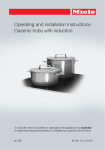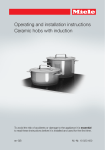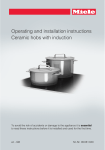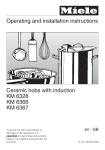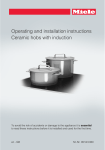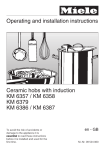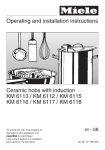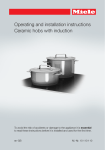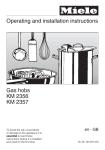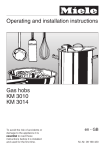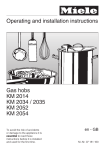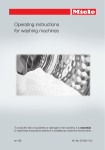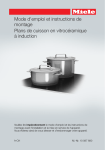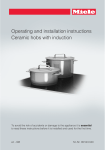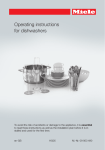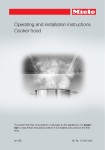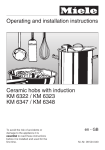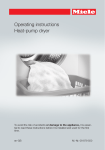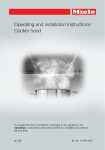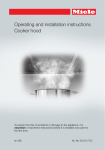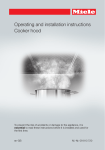Download Miele KM6325-1 hob
Transcript
Operating and installation instructions Ceramic hobs with induction To avoid the risk of accidents or damage to the appliance it is essential to read these instructions before it is installed and used for the first time. en-GB M.-Nr. 10 023 510 Contents Warning and Safety instructions .......................................................................... 4 Caring for the environment ................................................................................. 13 Overview ............................................................................................................... 14 Hob ........................................................................................................................ 14 KM 6325-1 ........................................................................................................ 14 KM 6362-1 / KM 6363-1 / KM 6364-1.............................................................. 15 Control symbols..................................................................................................... 16 Hob display symbols ............................................................................................. 16 Cooking zones ....................................................................................................... 17 Before using for the first time............................................................................. 19 Cleaning the hob for the first time ......................................................................... 19 Switching on the hob for the first time................................................................... 19 Induction ............................................................................................................... 20 The induction principle........................................................................................... 20 Noises .................................................................................................................... 21 Pans ....................................................................................................................... 22 Tips on saving energy ......................................................................................... 23 Power level range................................................................................................. 24 Operation .............................................................................................................. 25 Cooking zone rotary controls................................................................................. 25 Switching on .......................................................................................................... 25 Switching off .......................................................................................................... 25 Residual heat indicator .......................................................................................... 25 PowerFlex cooking area......................................................................................... 26 Auto heat-up .......................................................................................................... 27 Booster................................................................................................................... 28 Keeping warm ........................................................................................................ 30 Setting the keeping warm function ................................................................... 30 Safety features ..................................................................................................... 31 System lock ........................................................................................................... 31 Safety switch-off .................................................................................................... 31 Overheating protection .......................................................................................... 32 Cleaning and care ................................................................................................ 33 Ceramic surface ..................................................................................................... 34 Rotary controls....................................................................................................... 34 2 Contents Problem solving guide ......................................................................................... 35 Optional accessories ........................................................................................... 38 Miele@home / Con@ctivity................................................................................. 39 Signing on .............................................................................................................. 40 Safety instructions for installation ..................................................................... 41 Safety distances................................................................................................... 42 Hob with frame or bevelled edge ....................................................................... 46 Installation notes .................................................................................................... 46 Building-in dimensions ......................................................................................... 47 KM 6325-1 ........................................................................................................ 47 KM 6362-1 ........................................................................................................ 48 KM 6363-1 ........................................................................................................ 49 Installation.............................................................................................................. 50 Flush-fitted hobs .................................................................................................. 51 Installation notes .................................................................................................... 51 Building-in dimensions ......................................................................................... 52 KM 6364-1 ........................................................................................................ 52 Installation.............................................................................................................. 53 Electrical connection ........................................................................................... 55 Wiring diagram ...................................................................................................... 57 After sales service, data plate, guarantee ......................................................... 58 3 Warning and Safety instructions This hob complies with all relevant safety requirements. Inappro‐ priate use can, however, lead to personal injury and damage to property. To avoid the risk of accidents and damage to the appliance, please read these instructions carefully before installation and be‐ fore using it for the first time. They contain important notes on in‐ stallation, safety, use and maintenance. Miele cannot be held liable for damage caused by non-compli‐ ance with these instructions. Keep these instructions in a safe place and ensure that new users are familiar with the content. Pass them on to any future owner. 4 Warning and Safety instructions Correct application This hob is intended for domestic use and use in other similar en‐ vironments. This hob is not intended for outdoor use. It is intended for domestic use only to cook food and keep it warm. Any other use is not supported by the manufacturer and could be dangerous. People with reduced physical, sensory or mental capabilities, or lack of experience and knowledge who are not able to use the hob safely on their own must be supervised whilst using it. They may on‐ ly use it unsupervised if they have been shown how to use it in safe‐ ly and recognise and understand the consequences of incorrect op‐ eration. 5 Warning and Safety instructions Safety with children Children under 8 years of age must be kept away from the hob unless they are constantly supervised. Children 8 years and older may only use the hob unsupervised if they have been shown how to use it in a safe way and can recognise and understand the consequences of incorrect operation. Children must not be allowed to clean the hob unsupervised. Please supervise children in the vicinity of the hob and do not let them play with it. The hob gets hot when in use and remains hot for a while after being switched off. Keep children well away from the hob until it has cooled down and there is no danger of burning. Danger of burning. Do not store anything which might arouse a child's interest in stor‐ age areas above or next to the hob. Otherwise they could be temp‐ ted into climbing onto the appliance. Danger of burning or scalding. Place pots and pans on the cooking zone in such a way that chil‐ dren cannot pull them down and burn themselves. Danger of suffocation. Packaging, e.g. plastic wrappings, must be kept out of the reach of babies and children. Whilst playing, children could become entangled in packaging or pull it over their head and suffocate. Activate the system lock to ensure that children cannot switch on the hob inadvertently. 6 Warning and Safety instructions Technical safety Unauthorised installation, maintenance and repairs can cause considerable danger for the user. Installation, maintenance and re‐ pairs must only be carried out by a Miele authorised technician. Do not use a damaged appliance. It could be dangerous. Check the hob for visible signs of damage. Reliable and safe operation of this hob can only be assured if it has been connected to the mains electricity supply. The electrical safety of this hob can only be guaranteed when cor‐ rectly earthed. It is essential that this standard safety requirement is met. If in any doubt please have the electrical installation tested by a qualified electrician. To avoid the risk of damage to the hob, make sure that the con‐ nection data on the data plate (voltage and frequency) match the mains electricity supply before connecting it to the mains. Consult a qualified electrician if in doubt. Do not connect the hob to the mains electrical supply by a multi- socket adapter or extension lead. These are a fire hazard and do not guarantee the required safety of the appliance. For safety reasons, this hob may only be used after it has been built in. This hob must not be used in a non-stationary location (e.g. on a ship). Never open the casing of the hob. Touching or tampering with electrical connections or components and mechanical parts is highly dangerous to the user and can cause operational faults. While the hob is under guarantee, repairs should only be under‐ taken by a Miele authorised service technician. Otherwise the guar‐ antee is invalidated. 7 Warning and Safety instructions Miele can only guarantee the safety of the appliance when genu‐ ine original Miele replacement parts are used. Faulty components must only be replaced by Miele spare parts. The hob is not intended for use with an external timer switch or a remote control system. The hob must be connected to the electricity supply by a qualified electrician (see "Electrical connection"). If the connection cable is damaged, it must be replaced with a special connection cable type H 05 VV-F (PVC insulated). See "Elec‐ trical connection". The hob must be disconnected from the mains electricity supply during installation, maintenance and repair work. Ensure that power is not supplied to the appliance until after it has been installed or un‐ til any maintenance or repair work has been carried out. Danger of electric shock. Do not use the hob if it is faulty, or if the ceramic surface is cracked, chipped or damaged in any way. Switch it off immediately, discon‐ nect it from the mains electricity supply and contact Miele. If the hob is installed behind a furniture panel (e.g. a door), ensure that the door is never closed whilst the hob is in use. Heat and mois‐ ture can build up behind a closed furniture panel and cause subse‐ quent damage to the hob, the housing unit and the floor. Do not close the door until the residual heat indicators have gone out. In areas which may be subject to infestation by cockroaches or other vermin, pay particular attention to keeping the appliance and its surroundings in a clean condition at all times. Any damage which may be caused by cockroaches or other vermin will not be covered by the guarantee. 8 Warning and Safety instructions Correct use The hob gets hot when in use and remains hot for a while after being switched off. There is a danger of burning until the residual heat indicators go out. Due to the high temperatures radiated, objects left near the hob when it is in use could catch fire. Do not use the hob to heat up the room. Oil and fat can overheat and catch fire. Do not leave the hob unat‐ tended when cooking with oil and fat. If it does ignite do not attempt to put the flames out with water. Disconnect the hob from the mains and use a suitable fire blanket, saucepan lid, damp towel or similar to smother the flames. Flames could set the grease filters of a cooker hood on fire. Do not flambé under a cooker hood. Spray canisters, aerosols and other inflammable substances can ignite when heated. Therefore do not store such items or substances in a drawer under the hob. Cutlery inserts must be heat-resistant. Do not heat an empty pan. Do not heat up food in closed containers e.g. tins or sealed jars on the hob, as pressure can build up in the container, causing it to explode. Do not cover the hob, e.g. with a hob cover, a cloth or protective foil. The material could catch fire, shatter or melt if the hob is switch‐ ed on by mistake or if residual heat is still present. When the appliance is switched on either deliberately or by mis‐ take, or when there is residual heat present, there is the risk of any metal items left on the hob heating up, with the danger of burning. Depending on the material, other items left on the hob could also melt or catch fire. Damp pan lids might adhere to the ceramic sur‐ face and be difficult to dislodge. Do not use the appliance as a rest‐ ing place. Switch the cooking zones off after use. 9 Warning and Safety instructions You could burn yourself on the hot hob. Protect your hands with heat-resistant pot holders or gloves when handling hot pots and pans. Do not let them get wet or damp, as this causes heat to trans‐ fer through the material more quickly with the risk of scalding or burning yourself. When using an electrical appliance, e.g. a hand-held food blen‐ der, near the hob, ensure that the cable of the electrical appliance cannot come into contact with the hot hob. The insulation on the ca‐ ble could become damaged. Grains of salt, sugar and sand (e.g. from cleaning vegetables) can cause scratches if they get under pan bases. Make sure that the ce‐ ramic surface is clean before placing pans on it. Even a light object can cause damage in certain circumstances. Do not drop anything on the ceramic surface. Do not place hot pans on the display as this could cause damage to the electronics underneath. Do not place hot pans on the area around the display. Do not allow solid or liquid sugar, or pieces of plastic or alumini‐ um foil to get onto the cooking zones when they are hot, as they can damage the ceramic surface when it cools down. If this should oc‐ cur, switch off the appliance and scrape off all the sugar, plastic or aluminium residues whilst still hot, using a shielded scraper blade. Wear oven gloves. Allow the cooking zones to cool down and clean them with a suitable ceramic hob cleaning agent. Pans which boil dry can cause damage to the ceramic glass. Do not leave the hob unattended whilst it is being used. Only use pots and pans with smooth bases. Rough bases will scratch the ceramic glass. Lift pans into position on the hob. Sliding them into place can cause scuffs and scratches. 10 Warning and Safety instructions Induction heating works extremely quickly and so the base of the pan could heat up to the temperature at which oil or fat self-ignites within a very short time. Do not leave the hob unattended whilst it is being used. Heat oil or fat for a maximum of one minute. Do not use the Boos‐ ter function to heat oil or fat. For people fitted with a heart pacemaker: Please note that the area immediately surrounding the hob is electromagnetically charg‐ ed. It is very unlikely to affect a pacemaker. However, if in any doubt, consult the manufacturer of the pacemaker or your doctor. To prevent damage to items which are susceptible to electromag‐ netic fields, e.g. credit cards, digital storage devices, pocket calcula‐ tors, etc, do not leave them in the immediate vicinity of the hob. Metal utensils stored in a drawer under the hob can become hot if the appliance is used intensively for a long time. Do not store any metal items or utensils in a drawer under the hob. This hob is fitted with a cooling fan. If a drawer is fitted directly underneath the hob, ensure that there is sufficient space between the drawer and its contents and the underside of the appliance in or‐ der to ensure sufficient ventilation of the hob. Do not store pointed or small items or paper in the drawer. They could get in through the ventilation slots or be sucked into the housing by the fan and dam‐ age the fan or impair cooling. Do not use two pans on a cooking zone, extended zone or Pow‐ erFlex zone at the same time. If the pan only partially covers the cooking zone, the handle could become very hot. Ensure that you always place the pan in the middle of the cooking zone. 11 Warning and Safety instructions Cleaning and care Do not use a steam cleaning appliance to clean this hob. The steam could reach electrical components and cause a short cir‐ cuit. If the hob is built in over a pyrolitic oven, the hob should not be used whilst the pyrolitic process is being carried out, as this could trigger the overheating protection mechanism on the hob (see rele‐ vant section). 12 Caring for the environment Disposal of the packing mate‐ rial Disposing of your old appli‐ ance The packaging is designed to protect the appliance from damage during transportation. The packaging materials used are selected from materials which are environmentally friendly for disposal and should be recycled. Electrical and electronic appliances of‐ ten contain valuable materials. They al‐ so contain materials which, if handled or disposed of incorrectly, could be po‐ tentially hazardous to human health and to the environment. They are, however, essential for the correct functioning of your appliance. Please do not therefore dispose of it with your household waste. Recycling the packaging reduces the use of raw materials in the manufactur‐ ing process and also reduces the amount of waste in landfill sites. Please dispose of it at your local com‐ munity waste collection / recycling cen‐ tre or contact your Dealer for advice. Ensure that it presents no danger to children while being stored for disposal. 13 Overview Hob KM 6325-1 a PowerFlex cooking zone with TwinBooster b PowerFlex cooking zone with TwinBooster ab can be combined to form a PowerFlex cooking area c Cooking zone with Booster d Cooking zone with Booster e Display with cooking zone indicators f Control for the front left cooking zone g Control for the rear left cooking zone h Control for the front right cooking zone i Control for the rear left cooking zone 14 Overview KM 6362-1 / KM 6363-1 / KM 6364-1 a Cooking zone with WaterBoost b Cooking zone with Booster c PowerFlex cooking zone with TwinBooster d PowerFlex cooking zone with TwinBooster cd can be combined to form a PowerFlex cooking area e Display with cooking zone indicators f Control for the front left cooking zone g Control for the rear left cooking zone h Control for the front right cooking zone i Control for the rear left cooking zone 15 Overview Control symbols Symbol Description 0 Cooking zone off Keeping warm setting For switching on the PowerFlex cooking area B Booster level 1 B I/II TwinBooster/WaterBoost with 2 levels Cooking zone selection, example: front left Hob display symbols Symbol Description Cooking zone ready for use Keeping warm setting to Power level Auto heat-up Level 1 TwinBooster/WaterBoost Booster/Level 2 TwinBooster/WaterBoost No pan on cooking zone or pan unsuitable (see "Induction") Residual heat The system lock has been activated Demonstration mode activated Demonstration mode deactivated 16 Overview Cooking zones Cooking zone KM 6325-1 Rating in watts for 230 V** Ø in cm* 15–23 Normal TwinBooster, level 1 TwinBooster, level 2 2100 3000 3650 15–23 Normal TwinBooster, level 1 TwinBooster, level 2 2100 3000 3650 14–20 Normal Booster 1850 3000 10–16 Normal Booster 1400 2200 + 22–23 / 15x23–23x39 Normal TwinBooster, level 1 TwinBooster, level 2 3400 4800 7300 Total: 7300 * Pans of any diameter within the given range may be used. ** The wattage quoted may vary depending on the size and material of the pans used. 17 Overview Cooking zone KM 6362-1 / 6363-1 / 6364-1 Rating in watts for 230 V** Ø in cm* 10–23 Normal WaterBoost, level 1 WaterBoost, level 2 2300 3200 5000 14–20 Normal Booster 1850 3000 15–23 Normal TwinBooster, level 1 TwinBooster, level 2 2100 3000 3650 15–23 Normal TwinBooster, level 1 TwinBooster, level 2 2100 3000 3650 + 22–23 / 15x23–23x39 Normal TwinBooster, level 1 TwinBooster, level 2 3400 4800 7300 Total: 7300 * Pans of any diameter within the given range may be used. ** The wattage quoted may vary depending on the size and material of the pans used. 18 Before using for the first time Please stick the extra data plate for the appliance supplied with this doc‐ umentation in the space provided in the "After sales service, data plate, guarantee" section of this booklet. Remove any protective wrapping and stickers. Cleaning the hob for the first time Before using for the first use, clean the hob with a damp cloth only and then wipe dry. Switching on the hob for the first time The metal components have a protec‐ tive coating which may give off a slight smell when heated up for the first time. The induction coils may also give off a slight smell for the first few hours of op‐ eration. This smell will be less noticea‐ ble with each subsequent use before dissipating completely. The smell and any vapours given off do not indicate a faulty connection or ap‐ pliance and they are not hazardous to health. Please note that the heating up time on induction hobs is very much short‐ er than on conventional cooktops. 19 Induction The induction principle An induction coil is located under each cooking zone. When a cooking zone is switched on, this coil creates a magnet‐ ic field which impacts directly on the base of the pan and heats it up. The cooking zone itself is heated up indi‐ rectly by the heat given off by the pan. An induction cooking zone only works when a ferromagnetic pan is placed on it (see "Pans"). The induction cooking zone automatically recognises the size of the pan. The symbol flashes alternately with the power setting selected in one of the cooking zones – if it is switched on without a pan in place, or if the pan is unsuitable (non-magnetic base). – if the diameter of the base of the pan is too small, – if the pan is taken off the cooking zone when it is switched on. If a suitable pan is placed on the cook‐ ing zone within 3 minutes, the will go out and you can continue as normal. If no pan or an unsuitable pan is placed on the cooking zone, the cooking zone will switch off automatically after 3 mi‐ nutes. 20 When the appliance is switched on either deliberately or by mistake, or when there is residual heat present, there is the risk of any metal items placed on the hob (e.g. cutlery) heating up. Danger of burning. Do not use the hob as a resting place for items. Switch the cooking zones off after use by turning the control to "0". Induction Noises When using an induction cooking zone, the following noises can occur in the pan, depending on what it is made of and how it has been constructed. On the higher power settings, it might buzz. This will decrease or cease alto‐ gether when the power setting is re‐ duced. If the pan base is made of layers of dif‐ ferent materials (e.g. in a sandwiched base), it might emit a cracking sound. Whistling might occur if linked zones (see "Booster") are being used at the same time, and the pans also have bases made of layers of different mate‐ rials. You might hear a clicking sound from the electronic switches, especially on lower power settings. You might hear a whirring sound when the cooling fan switches on. It switches on to protect the electronics when the hob is being used intensively. The fan may continue to run after the appliance has been switched off. 21 Induction Pans The following pan types are suitable: – Stainless steel with a base that can be magnetised, – enamelled steel, – cast iron. The following pan types are not suita‐ ble: – Stainless steel pans without a mag‐ netic base, – aluminium and copper pans, – glass, ceramic or earthenware pots and pans. To test whether a pot or pan is suitable for use on an induction hob, hold a magnet to the base of the pan. If the magnet sticks, the pan is suitable. If an unsuitable pan is used, the symbol will flash alternately with the power lev‐ el set. The composition of the pan base can affect the evenness of the cooking re‐ sults (e.g. when browning pancakes). – To make optimum use of the cooking zones, choose a pan with a suitable base diameter (see "Guide to the ap‐ pliance - Cooking zones"). If the pan is too small, it will not be recognised and the symbol will flash alternately with the power level set. – Only use pots and pans with smooth bases. Rough bases will scratch the ceramic glass. – Lift pans into position on the hob. Sliding them into place can cause scuffs and scratches. 22 – Often the maximum diameter quoted by manufacturers refers to the diam‐ eter of the top rim of the pot or pan. The diameter of the base (generally smaller) is more important. Tips on saving energy – Use a lid whenever possible to mini‐ mise heat loss. – Select a smaller pan when cooking small quantities. A smaller pan uses less energy than a larger pan with very little in it. – Cook with as little water as possible. – Once food has come to the boil or the oil in the pan is hot enough for frying, reduce the heat to a lower set‐ ting. – Use a pressure cooker to reduce cooking times. 23 Power level range Keeping warm Melting butter Dissolving gelatine Melting chocolate Making milk puddings Warming small quantities of liquid Cooking rice Defrosting frozen vegetables Making porridge Warming liquid and semi-solid foods Making omelettes or lightly frying eggs Steaming fruit Cooking dumplings Steaming vegetables and fish Defrosting and reheating frozen food Gently frying eggs (without overheating the fat) Bringing large quantities of food to the boil, e.g. casseroles. Thickening custard and sauces, e.g. hollandaise Gently braising meat, fish and sausages (without overheating the fat) Frying pancakes, potato fritters etc. Cooking stew Boiling large quantities of water Bringing to the boil Setting range h 1-2 2 3 3 3 4 4 5 5 6 6-7 6-7 7 8 9 These settings should only be taken as a guide. The power of the induction coils will vary depending on the size and material of the pan. For this reason, it is possible that the set‐ tings will need to be adjusted slightly to suit your pans. As you use the hob, you will get to know which settings suit your pans best. When using new pans that you are not familiar with, set the power level below the one specified. 24 Operation Fire hazard. Residual heat indicator Do not leave the hob unattended whilst it is being used. Please note that the heating up time on induction hobs is very much shorter than on conventional hobs. If the cooking zone is still hot, the resid‐ ual heat indicator will light up after it has been switched off. Cooking zone rotary controls The cooking zone rotary controls must not be turned past B I or B I/II to 0. Switching on Turn the cooking zone rotary control clockwise until the setting you want appears in the display. The lines of the residual heat indicator go out one after another as the cooking zone cools down. The last horizontal line only goes out when the cooking zone is safe to touch. Danger of burning. Do not touch the cooking zones whilst the residual heat indicators are lit up. Switching off Turn the rotary control anti-clockwise to 0. The power level will go out in the dis‐ play. 25 Operation PowerFlex cooking area The PowerFlex cooking zones can be combined to form a PowerFlex cooking area (see "Guide to the appliance Hob"). Settings for the cooking area are controlled by the front PowerFlex cook‐ ing zone. Switching on Turn the rotary control for the rear cooking zone clockwise to . will light up in the display for the rear cooking zone. Turn the rotary control for the front cooking zone clockwise until the power level you require lights up in the cooking zone display. Switching off Turn both rotary controls anti-clock‐ wise to 0. 26 Operation Auto heat-up Continued cook‐ ing setting Heat-up time [min : sec] 1 approx. 0 : 15 2 approx. 0 : 15 3 approx. 0 : 25 4 approx. 0 : 50 Activating 5 approx. 2 : 00 Turn the rotary control anti-clockwise and hold until flashes once in the cooking zone display. 6 approx. 5 : 50 7 approx. 2 : 50 8 approx. 2 : 50 9 – When Auto heat-up has been activated, the cooking zone switches on automati‐ cally at the highest power setting and then switches to the continued cooking setting. The heat-up time depends on which continued cooking setting has been chosen (see chart). Now turn the rotary control clockwise until the continued cooking setting lights up in the cooking zone display. The continued cooking setting selected will flash alternating with during the heat-up time (see chart). Altering the continued cooking setting while the cooking zone is heating up deactivates Auto heat-up. Deactivating Select a different power level. 27 Operation Booster The cooking zones are equipped with a one stage Booster, two stage Water‐ Boost or TwinBooster (see "Guide to the appliance - Hob"). When activated, the power is boosted for a maximum of 15 minutes so that large quantities can be heated quickly, e.g. when boiling water for cooking pasta. The booster function can only be used on two cooking zones at the same time. The cooking zone will automatically re‐ vert to power level 9 at the end of the booster time. 28 Cooking zones are networked in pairs to supply the power for the booster function. When the booster function is selected, a proportion of energy is taken away from the linked cooking zone and the following happens within the pairs – Auto heat-up is deactivated – the power level is reduced – the linked cooking zone is switched off. Operation To switch on the Booster Turn the rotary control clockwise gen‐ tly past the point of resistance to B and back to the point of resistance. will appear in the cooking zone dis‐ play. Switching off the Booster / Water‐ Boost / TwinBooster Select a different power level. The booster symbol will go out. Switching on WaterBoost / Twin‐ Booster, level 1 Turn the rotary control clockwise gen‐ tly past the point of resistance to B I/II and back to the point of resist‐ ance. will appear in the cooking zone dis‐ play. Switching on WaterBoost / Twin‐ Booster, level 2 Turn the rotary control clockwise gen‐ tly past the point of resistance to B I/II and back to the point of resist‐ ance. Turn the rotary control again gently past the point of resistance to B I/II and back to the point of resistance. will appear in the cooking zone dis‐ play. 29 Operation Keeping warm The keeping warm function is for keeping food that has just been cooked warm, i.e. food that is still hot. It is not for reheating food that has gone cold. If the keeping warm function has been activated, the cooking zone will switch off automatically after a maximum of 2 hours. – Only use pots and pans for keeping food warm and cover with a lid. – You do not have to stir food while it is being kept warm. – Nutrients are lost when food is cooked, and continue to diminish when food is kept warm. The longer food is kept warm for, the greater the loss of nutrients. Try to ensure that food is kept warm for as short a time as possible. 30 Setting the keeping warm function Turn the control clockwise to . will appear in the cooking zone dis‐ play. Safety features System lock The system lock is deactivated if there is an interruption to the power supply. The system lock can only be activated if all the cooking zones are switched off. Your hob is equipped with a system lock to prevent the cooking zones being switched on inadvertently. Safety switch-off The safety switch-off mechanism is triggered automatically if one of the cooking zones is heated for an unusual‐ ly long period of time. This period of time depends on the power level selec‐ ted. Once exceeded, the cooking zone switches off and the residual heat indi‐ cators appear. The cooking zone can be operated again after it has been switched off and back on If a power level is selected when the system lock is activated, appears in the display for approx. 3 seconds. Activating Turn the rotary controls for both front cooking zones anti-clockwise to the point of resistance at the same time and hold until appears. Deactivating Turn the rotary controls for both front cooking zones anti-clockwise to the point of resistance at the same time and hold until goes out. 31 Safety features Overheating protection All the induction coils and cooling ele‐ ments for the electronics are fitted with an overheating protection mechanism. Before the induction coils or cooling el‐ ements get too hot, the overheating protection mechanism cuts in in one of the following ways: – any booster function in operation will be turned off. – the set power level will be reduced, – one or more cooking zones will switch off automatically. Turn the rotary controls for all the affec‐ ted cooking zones to "0". The affected cooking zones can only be used again as usual once the induction coil or cool‐ ing element has cooled down to a safe level. The overheating mechanism can be triggered by: – heating up an empty pan – fat or oil being heated on a high pow‐ er level. – insufficient ventilation of the under‐ side of the hob. – a hot cooking zone being switched on after an interruption to the power supply. If, despite removing the cause, the overheating protection mechanism trig‐ gers again, contact Miele Service. 32 Cleaning and care Danger of burning. Unsuitable cleaning agents The cooking zones must be switch‐ ed off. The hob must have cooled down. To avoid damaging the surfaces of your appliance, do not use: Danger of injury. – cleaning agents containing soda, al‐ kalines, ammonia, acids or chlorides, The steam from a steam cleaning appliance could reach electrical components and cause a short cir‐ cuit. Do not use a steam cleaner to clean the hob. The use of unsuitable cleaning agents can cause the surfaces to discolour or alter. All surfaces are susceptible to scratching. Remove any cleaning agent residues immediately. – washing-up liquid, – cleaning agents containing descaling agents – stain or rust removers, – abrasive cleaning agents, e.g. pow‐ der cleaners and cream cleaners, – solvent-based cleaning agents, – dishwasher cleaner, – grill and oven cleaners, – glass cleaning agents, – hard, abrasive brushes or sponges, e.g. pot scourers, or sponges which have been previously used with abra‐ sive cleaning agents, – melamine eraser blocks, 33 Cleaning and care Ceramic surface Do not clean the area between the glass-ceramic surface and the frame or the frame and the worktop with sharp, pointed objects. This could damage to the seals. Do not use washing-up liquid to clean the appliance as washing-up liquid will not remove all soiling and deposits. It will form an invisible coating which will cause permanent discolouration of the ceramic surface. Clean the hob regularly with a suita‐ ble ceramic hob cleaning agent. Wipe all coarse soiling off using a damp cloth. Stubborn soiling may need to be removed with a shielded scraper blade. Then clean the hob with Miele ceramic and stainless steel hob cleaner (see "Optional accessories") or a suitable proprietary ceramic hob cleaner applied with kitchen paper or a clean cloth. Do not apply cleaner whilst the hob is still hot, as this could result in marking. Please follow the manufacturer's in‐ structions. Finally wipe the hob with a damp cloth, then dry with a soft, dry cloth. Residues can burn onto the appliance the next time it is used and cause damage to the ceramic surface. Ensure that all cleaning agent residues are removed. Spots caused by limescale, water and aluminium residues (spots with a metal‐ lic appearance) can be removed using Miele's ceramic and stainless steel hob cleaner. 34 Danger of burning. Protect your hands with oven gloves before using a shielded scraper blade to remove sugar, plastic or alu‐ minium residues from the hot hob. Should any sugar, plastic or alumini‐ um foil spill or fall onto a hot cooking zone while it is in use, first switch off the appliance. Then carefully scrape off all the sugar, plastic or aluminium resi‐ dues from the hob immediately whilst they are still hot, using a shielded scra‐ per blade. Allow the appliance to cool down, and then clean as described above. Rotary controls Clean the rotary controls using a solu‐ tion of warm water and a little washingup liquid applied with a soft sponge. Problem solving guide With the aid of the following guide, minor problems can be easily corrected with‐ out contacting Miele. If having followed the suggestions below, you still cannot resolve the problem, please contact Miele (see end of this booklet for contact details). Danger of injury. Installation, maintenance and repairs to electrical applian‐ ces must only be carried out by a suitably qualified and competent person in strict accordance with current local and national safety regulations. Do not open the casing of the appliance. Repairs and other work by unqualified persons could be dangerous and Miele cannot be held liable for unauthorised work. Problem Cause and remedy The hob or cooking zones cannot be switched on. There is no power to the hob. Check if the mains fuse has tripped. If it has, con‐ tact a qualified electrician or Miele (minimum fuse rating - see data plate). There may be a technical fault. Disconnect the appliance from the electricity sup‐ ply for approx. 1 minute. To do this: – switch off at the isolator, or – disconnect the mains fuse. If, after resetting the trip switch in the mains fuse box and switching the appliance back on, the ap‐ pliance will still not heat up, contact a qualified electrician or Miele. A smell and vapours are The metal components have a protective coating. given off when the new When the appliance is used for the first time, this appliance is being used. causes a smell and possibly also vapour. The material from which the induction coils are made also gives off a smell in the first few hours of operation. This smell will be less noticeable with each subsequent use be‐ fore dissipating completely. The smell and any vapour given off do not indicate a faulty connection or appli‐ ance and they are not hazardous to health. The symbol flashes alternately with the power level selected or in the display for one of the cooking zones. There is no pan on the cooking zone, or the pan is unsuitable. Use a suitable pan (see "Pans"). 35 Problem solving guide Problem Cause and remedy After the hob has been Demonstration mode is activated. switched on appears Turn the rotary control for the front left cooking in the display for a few zone anti-clockwise and hold. seconds. Turn the rotary control for the right front cooking The cooking zones do zone twice briefly anti-clockwise and then turn an‐ not heat up. ti-clockwise and hold until appears in the display. A cooking zone switches off automati‐ cally. It has been operated for too long. You can use the cooking zone again by switching it back on (see "Safety switch-off"). The Booster has deacti‐ The overheating protection mechanism has been acti‐ vated early automatical‐ vated. ly. See "Overheating protection". The cooking zone is not The overheating protection mechanism has been acti‐ working in the usual vated. way on the power set‐ See "Overheating protection". ting selected. Power level 9 is auto‐ Operating both zones at power level 9 would exceed matically reduced if you the permitted maximum power for the two zones. select power level 9 on Use a different cooking zone. two linked cooking zones at the same time. The food in the pan does not heat up when the Auto heat-up func‐ tion is switched on. A large amount of food is being heated up. Start cooking at the highest power level and then turn down to a lower one manually later on. The pan is not conducting heat properly. Use a different pot or pan which conducts heat properly. An operating noise can The fan will continue running until the appliance has be heard after the appli‐ cooled down. It will then switch itself off automatical‐ ance has been switched ly. off. 36 Problem solving guide Problem is flashing in the display of one or more cooking zones. The rotary control is not at "0", a power level has been set for the cook‐ ing zone. The cooking zone is not heating up. appears in the display or flashes alternately with . Cause and remedy The rotary control for the cooking zone has been turned to the point of resistance clockwise or anticlockwise for longer than 30 seconds. Turn the rotary control to 0. If the fault message does not go out, there could be a technical fault. Call Miele. There was an interruption to the power supply during operation. The cooking zone was switched on more than 3 mi‐ nutes ago without a suitable pan being placed on it. The maximum operating time for the cooking zone has been exceeded. Turn the rotary control to 0. The cooking zone can now be used again. flashes in the dis‐ There is an electronic unit fault. Interrupt the power supply to the hob for approx. 1 play alternating minute. If the problem persists after power is re‐ with numbers. stored, please contact Miele. 37 Optional accessories Miele offer a comprehensive range of useful accessories as well as cleaning and conditioning products for your Miele appliances. Cleaning and care products Ceramic and stainless steel hob cleaner 250 ml These can be ordered online at: Removes heavy soiling, limescale de‐ posits and aluminium residues or from Miele (see end of this booklet for contact details). Microfibre cloth Pans Miele offer a wide range of pans which are perfect for Miele hobs. Please refer to the Miele website for more details on individual products. – Pans in various sizes – Frying pan with lid – Anti-stick pans – Wok – Gourmet oven dishes 38 Removes finger marks and light soiling Miele@home / Con@ctivity Your hob is communication-enabled and via the stick supplied with selected cooker hoods can – be connected to the Miele@home system, Further information regarding Miele@home and Con@ctivity is availa‐ ble on the internet and in the instruction manuals of the various components. – communicate with the cooker hood (Con@ctivity). Miele@home system Communication-enabled appliances send operating status information to a display appliance (SuperVision appli‐ ance, Notebook, tablet etc.). The sys‐ tem also enables integration into a household bus system (Miele Gateway or QIVICON Smart Home Platform). Con@ctivity The hob sends information on its oper‐ ating status to the cooker hood. Opera‐ tion of the cooker hood occurs auto‐ matically in conjunction with the hob. 39 Miele@home / Con@ctivity Signing on If you want to sign the hob – on to the Miele@home system, first prepare the signing on procedure on the master (display) appliance. – on to the Con@ctivity system, first sign on the cooker hood. Disconnect the hob from the mains electricity supply. Connect the stick to the hob (see the installation instructions for the stick). Reconnect the hob to the mains elec‐ tricity supply. The signing on procedure must be carried out within 10 minutes after re‐ connecting the electricity supply. Start signing on the cooker hood or the master appliance (see the rele‐ vant instructions). Remove any pots or pans from the hob. There must not be any pots or pans on the hob when the signing on proc‐ ess is being carried out. Set power level "1" for all the cooking zones. The symbol will flash. Wait at least 1 minute and turn all the cooking zone rotary controls to "0". Finish signing on the cooker hood/ master appliance (see the relevant in‐ structions). 40 Safety instructions for installation The appliance must only be installed and connected to the electricity sup‐ ply by a suitably qualified and competent person in strict accordance with cur‐ rent national and local safety regulations. Fit the wall units and cooker hood before fitting the hob to avoid damaging the hob. The veneer or laminate coatings of worktops (or adjacent kitchen units) must be treated with 100 °C heat-resistant adhesive which will not dissolve or distort. Any backmoulds must be of heat-resistant material. The hob must not be installed over a fridge, fridge-freezer, freezer, dishwasher, washing machine, washer-dryer or tumble dryer. This hob must not be installed above ovens or cookers unless these have a built-in cooling down fan. After installation, ensure that nothing can come into contact with the connection cable and that it is without hindrance. The electrical cable may not come into contact with any moving kitchen component (e.g. a drawer) or be subject to mechanical ob‐ struction which could damage it. Observe carefully the safety clearances listed on the following pa‐ ges. All dimensions are given in mm. 41 Safety distances Safety distance above the hob A minimum safety distance must be maintained between the appliance and the cooker hood above it. See the cooker hood manufacturer's operating and installation instructions for details. If the manufacturer's instructions are not available for the cooker hood, a minimum safety distance of at least 760 mm must be maintained. For any flam‐ mable objects (e.g. utensil rails, wall units etc) a minimum safety distance of at least 760 mm must be maintained between them and the appliance below. When two or more appliances which have different safety distances are installed together below a cooker hood, you should observe the great‐ est safety distance. 42 Safety distances Safety distances to the sides and back of the hob Ideally the hob should be installed with plenty of space on either side. There may be a wall at the rear or a tall unit or wall on one side (right or left) (see illus‐ trations). Minimum distance between the back of the worktop cut-out and the rear edge of the worktop: 50 mm Not allowed Minimum distance between the worktop cut-out and a wall or tall unit to the right of it: 50 mm. Minimum distance between the worktop cut-out and a wall or tall unit to the left of it: 50 mm. Recommended Not recommended Not recommended 43 Safety distances Minimum safety distances un‐ derneath the hob To ensure sufficient ventilation to the hob, a certain gap must be left between the underside of the hob and any oven, interim shelf or drawer. The minimum gap between the under‐ side of the hob and – the top of an oven is 15 mm. – the top of an interim shelf is 15 mm. – the base of a drawer is 75 mm. 44 Interim shelf It is not necessary to fit an interim shelf underneath the hob but one may be fit‐ ted if you wish. Leave a gap of 10 mm at the back of the shelf to accommodate the cable. We recommend a gap at the front of the shelf of 20 mm to ensure good ventila‐ tion. Safety distances Safety distance when installing the appliance near a wall with additional niche cladding A minimum safety distance must be maintained between the worktop cut-out and any niche cladding to protect it from heat damage. If the niche cladding is made from a combustible material (e.g. wood) a minimum safety distance of 50 mm must be maintained between the cut-out and the cladding. If the niche cladding is made from a non-combustible material (e.g. metal, natural stone, ceramic tiles) the minimum safety distance between the cut-out and the cladding will be 50 mm less the thickness of the cladding. Example: 15 mm niche cladding 50 mm - 15 mm = minimum safety distance of 35 mm Flush-fitted hob Hob with frame or bevelled edge Masonry Niche cladding dimension x = thickness of the niche cladding material Worktop Worktop cut-out Minimum safety distance for combustible materials 50 mm non-combustible materials 50 mm less dimension x 45 Hob with frame or bevelled edge Installation notes Tiled worktop Seal between the hob and the work‐ top Do not use sealant between the hob and the worktop. This could result in damage to the hob or the worktop if the hob ever needs to be removed for servicing. The sealing strip under the edge of the top part of the appliance pro‐ vides a sufficient seal for the work‐ top. 46 Grout lines and the hatched area un‐ derneath the hob frame must be smooth and even. If they are not the hob will not sit flush with the worktop and the sealing strip underneath the hob will not provide a good seal be‐ tween the hob and the worktop. Hob with frame or bevelled edge Building-in dimensions KM 6325-1 a Front b Casing depth c Mains connection box d Miele@home/Con@ctivity connection The mains connection cable (1440 mm long) is supplied separately with the hob. 47 Hob with frame or bevelled edge KM 6362-1 a Front b Casing depth c Mains connection box d Miele@home/Con@ctivity connection The mains connection cable (1440 mm long) is supplied separately with the hob. 48 Hob with frame or bevelled edge KM 6363-1 a Front b Casing depth c Mains connection box d Miele@home/Con@ctivity connection The mains connection cable (1440 mm long) is supplied separately with the hob. 49 Hob with frame or bevelled edge Installation Installing the hob Preparing the worktop Feed the mains connection cable down through the cut-out. Make the worktop cut-out as shown in the building-in diagram. Observe the safety distances (see "Safety dis‐ tances"). Seal the cut surfaces with a suitable sealant to avoid swelling caused by moisture. The sealant must be heatresistant. Make sure that the sealant does not come into contact with the top of the worktop. The seal underneath the hob will hold it securely in the cut-out. Any gap be‐ tween the frame and worktop will re‐ duce with time. Connecting the mains connection cable to the appliance The mains connection cable must only be connected by a suitably qualified and competent person. Follow the instructions in the wiring diagram (see "Electrical connection Wiring diagram"). 50 Place the hob centrally in the cut-out. When doing this, make sure that the seal under the hob sits flush with the worktop on all sides. This is impor‐ tant to ensure an effective seal all round. Do not use sealant (e.g. silicone). If the seal does not meet the worktop correctly on the corners, the corner ra‐ dius (≤ R4) can be carefully scribed to suit. Connect the hob to the mains. Check that the hob works. Flush-fitted hobs Installation notes Flush fit hobs are only suitable for in‐ stallation in natural stone (granite, marble), tiled or solid wood worktops. Certain models are suitable for build‐ ing into glass worktops - please see advice under "Building-in dimen‐ sions". When using a worktop made from any other material, please check first with the worktop manufacturer that it is suitable for installing a flush fit hob. The hob can be installed – in a suitable cut-out in a natural stone worktop. – in a suitable cut-out in a tiled or solid wood worktop or a glass worktop with a wooden support frame. The frame must be provided on site, and is not supplied with the appliance. The internal width of the base unit must be at least as wide as the inter‐ nal cut-out width for the hob (see "Building-in dimensions"). This is to ensure that the casing can be easily removed for maintenance. If the un‐ derside of the hob is not freely acces‐ sible after installation, any sealant used to plug the gaps around the ap‐ pliance must be removed to enable the hob to be lifted out of the cut-out should this be necessary. 51 Flush-fitted hobs Building-in dimensions KM 6364-1 a Front d Stepped cut-out b Casing depth e Miele@home/Con@ctivity connec‐ tion c Mains connection box The mains connection cable (1440 mm long) is supplied separately with the hob. Please observe the detailed diagrams for cut-out dimensions in natural stone worktops. 52 Flush-fitted hobs Installation Solid wood, tiled and glass worktops Natural stone worktops a Worktop a Worktop b Hob b Hob c Gap c Gap d Wooden frame 13 mm (to be provi‐ ded on site) As the ceramic glass and the worktop cut-out have a certain dimensional tol‐ erance, the size of gap can vary (min. 1 mm). As the ceramic glass and the worktop cut-out have a certain dimensional tol‐ erance, the size of gap can vary (min. 1 mm). d Stepped cut-out 53 Flush-fitted hobs Preparing the worktop Make the worktop cut-out as shown in "Building-in dimensions". Observe the safety distances (see "Safety dis‐ tances"). Solid wood, tiled and glass worktops: Fix the wooden frame 7 mm below the top edge of the worktop (see dia‐ gram). Connecting the mains connection cable to the appliance The mains connection cable must only be connected by a suitably qualified and competent person. Follow the instructions in the wiring diagram (see "Electrical connection Wiring diagram"). Installing the hob Feed the mains connection cable down through the cut-out. Centre the hob in the cut-out. Connect the hob to the mains. Check that the hob works. Seal the remaining gap with a sili‐ cone sealant that is heat-resistant to at least 160°C. For natural stone worktops and natu‐ ral stone tiles, only use silicone seal‐ ant that is specially formulated for natural stone, and observe the seal‐ ant manufacturer's instructions. 54 Electrical connection Danger of injury. Connection Miele cannot be held liable for unau‐ thorised installation, maintenance and repair work as this can be dan‐ gerous to users. Miele cannot be held liable for dam‐ age or injury caused by incorrect in‐ stallation, maintenance or repair work, or by an inadequate or faulty earthing system (e.g. electric shock). This hob must be connected to the mains electrical supply by a suitably qualified and competent person, in accordance with current local and national safety regulations (BS 7671 in the UK). After installation ensure that all elec‐ trical components are shielded and cannot be accessed by users. AC 230 V, 50 Hz The connection data is quoted on the dataplate. It must match the household supply. Please see wiring diagram for connec‐ tion. (N.B. This appliance is supplied single phase only in the UK / AUS / NZ). Residual current device For extra safety, it is advisable to pro‐ tect the appliance with a suitable resid‐ ual current device (RCD) with a trip range of 30 mA. Separators The appliance must be able to be dis‐ connected from the mains on all poles by disconnecting devices. When switched off there must be an all-pole contact gap of at least 3 mm in the iso‐ lator switch. Disconnecting devices in‐ clude overcurrent protection and circuit breakers. 55 Electrical connection Disconnecting from the mains Danger of electrical shock. After disconnection, ensure the ap‐ pliance cannot be switched back on by mistake. To disconnect the appliance from the mains power supply, do one of the fol‐ lowing depending on installation: Safety fuses Completely remove fuses Automatic circuit breakers Press the (red) button until the middle (black) button springs out. Built-in circuit breakers Circuit breakers, type B or C: switch the on-off switch from 1 (on) to 0 (off). Residual current device (RCD) Switch the main switch from 1 (on) to 0 (off) or press the test button. Mains connection cable The hob must be connected to the electrical supply with a special connec‐ tion cable, type H 05 VV-F (PVC insula‐ ted) with a suitable diameter. Please see wiring diagram for connec‐ tion. (N.B. This appliance is supplied single phase only in the UK / AUS / NZ). See the data plate on the hob for the correct voltage and frequency. Connecting the mains cable Danger of electrical shock. The mains connection cable must be fitted by a suitably qualified and competent person in accordance with current local and national safety regulations. The wires in the mains cable are col‐ oured in accordance with the follow‐ ing code: Green/yellow = earth Blue = neutral Brown = live The earth lead must be connected to the point marked . If the mains cable needs to be replaced it must be replaced with a special con‐ nection cable, type H 05 VV-F (PVC-in‐ sulated), available from Miele. The connection data is quoted on the data plate. 56 Electrical connection Wiring diagram a b c d e L1 L2 L3 N 200-240 V~ 200-240 V~ 200-240 V~ a b c d e L1 L2 N 200-240 V~ 200-240 V~ (L3) a b c d e L1 200-240 V~ N (L2) 57 After sales service, data plate, guarantee After sales service In the event of any faults which you cannot easily remedy, please contact – your Miele Dealer, or – Miele See end of this booklet for contact details. When contacting your Dealer or Miele, please quote the model and serial number of your appliance. Data plate Space in which to stick the extra data plate supplied with the appliance. Ensure that the model number is the same as the one on the back page of these instruc‐ tions. 58 United Kingdom Miele Co. Ltd. Fairacres, Marcham Road Abingdon, Oxon, OX14 1TW Customer Contact Centre Tel: 0330 160 6600 E-mail: [email protected] Internet: www.miele.co.uk Australia Miele Australia Pty. Ltd. ACN 005 635 398 ABN 96 005 635 398 1 Gilbert Park Drive, Knoxfield, VIC 3180 Tel: 1300 464 353 Internet: www.miele.com.au China Miele (Shanghai) Trading Ltd. 1-3 Floor, No. 82 Shi Men Yi Road Jing' an District 200040 Shanghai, PRC Tel: +86 21 6157 3500, Fax: +86 21 6157 3511 E-mail: [email protected], Internet: www.miele.cn Miele (Hong Kong) Limited 41/F - 4101, Manhattan Place 23 Wang Tai Road Kowloon Bay, Hong Kong Tel: (852) 2610 1331, Fax: (852)2610 1013 Email: [email protected] India Miele India Pvt. Ltd. Ground Floor, Copia Corporate Suites Plot No. 9, Jasola New Delhi - 110025 Tel: 011-46 900 000, Fax: 011-46 900 001 E-mail: [email protected], Internet: www.miele.in Ireland Miele Ireland Ltd. 2024 Bianconi Avenue Citywest Business Campus, Dublin 24 Tel: (01) 461 07 10, Fax: (01) 461 07 97 E-Mail: [email protected], Internet: www.miele.ie Manufacturer: Miele & Cie. KG Carl-Miele-Straße 29, 33332 Gütersloh, Germany 59 Malaysia Miele Sdn Bhd Suite 12-2, Level 12 Menara Sapura Kencana Petroleum Solaris Dutamas No. 1, Jalan Dutamas 1 50480 Kuala Lumpur, Malaysia Phone: +603-6209-0288 Fax: +603-6205-3768 New Zealand Miele New Zealand Limited IRD 98 463 631 Level 2, 10 College Hill Freemans Bay, Auckland 1011, NZ Tel: 0800 464 353 Internet: www.miele.co.nz Singapore Miele Pte. Ltd. 163 Penang Road # 04 - 03 Winsland House II Singapore 238463 Tel: +65 6735 1191, Fax: +65 6735 1161 E-Mail: [email protected] Internet: www.miele.sg South Africa Miele (Pty) Ltd 63 Peter Place, Bryanston 2194 P.O. Box 69434, Bryanston 2021 Tel: (011) 875 9000, Fax: (011) 875 9035 E-mail: [email protected] Internet: www.miele.co.za United Arab Emirates Miele Appliances Ltd. P.O. Box 11 47 82 Gold & Diamond Park, Sheikh Zayed Road Building 6 / Offices Nos. 6-214 to 6-220 Dubai Tel: +971-4-341 84 44 Fax: +971-4-341 88 52 E-Mail: [email protected] Internet: www.miele.ae KM 6325-1 / KM 6362-1 / KM 6363-1 / KM 6364-1 en-GB M.-Nr. 10 023 510 / 00




























































